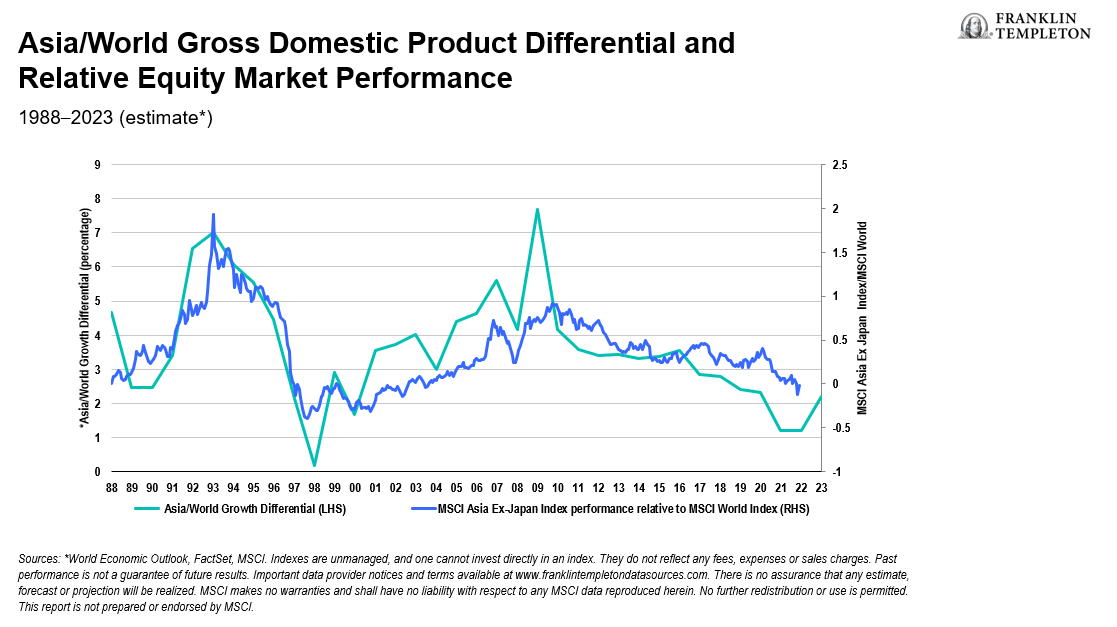China’s decision to move away from its zero-COVID policies and pivot toward prioritizing growth should prove a significant catalyst for emerging Asian equity markets. A peak in US inflation may lead the US Federal Reserve to adjust its pace of rate increases, which is turning the US dollar from a headwind to tailwind. These shifts have positive implications for liquidity, and in turn, for emerging Asian equities.
We believe market performance in 2023 is likely to be better than 2022 as negative news on known factors (inflation, war, China) may only have a limited downside impact on markets, whereas positive news could be the catalyst for a valuation re-rating and market gains. Key drivers of our optimism include:
- The performance of emerging Asian equities relative to emerging markets (EM) overall has been linked with the trend in Asian and world relative economic growth trends. With the economic growth differential forecast1 to move in favor of Asia in 2023, equity market performance trends should also favor the relative performance of emerging Asia over developed market (DM) equities.
- China’s pivot away from its zero-COVID policies and the dismantling of many of the restrictions on the freedom of movement is a significant change. Economic and earnings growth in China slowed significantly in 2022 due to sudden lockdowns, the crackdown in platform companies and the tightening of liquidity in the real estate sector. With the focus now pivoting to revitalizing growth, policies to support these sectors are being rolled out, which we expect should drive a recovery in earnings growth forecasts and improved market performance.
Pivoting from zero-COVID policy
With China pivoting away from its zero-COVID policy, Southeast Asia should prove a key beneficiary of a resumption in Chinese outbound tourism. Prior to COVID-19, China accounted for 25% of tourist arrivals in Thailand,2 but fell to almost zero in 2021 and less than 1% in 2022. Vietnam and Cambodia will also likely benefit from the resumption in Chinese tourism.
Inflationary pressures in Asia have been more muted relative to developed markets, as well as other EM regions, including the Middle East, Eastern Europe and Latin America. This reflects cheaper energy imports from Russia as well as adequate harvests, which has kept food price inflation in check and subdued wage inflation.
The higher share of domestic demand in gross domestic product drives the uncorrelated nature of returns in selected Asian markets, including India and Indonesia, relative to developed markets. At a time of slowing global growth, investors with lower risk appetite can potentially benefit from increased allocation to these markets. The meeting at the G20 summit in Bali in November between China’s President Xi Jinping and US President Joe Biden put a floor on US/China relations. Future relations are likely to be governed by the 3C framework: communication and coordination with competition.
Improved communication and coordination should be positive for investors and reduce the tail risk in asset markets. While competition creates uncertainty over future trade and investment policies, Asian companies have been diversifying their production bases as a way to reduce the impact of increased competition between the two countries.
We believe that combining these drivers with the valuation discount of Asian equities relative to DMs, as well as their own historic valuations,3 creates a powerful argument for strong performance in emerging Asian equities in 2023.
Asia is home to leading companies of the future, ranging from solar to electric vehicle batteries to semiconductors. Structural drivers include digitalization and decarbonization, which are creating opportunities and inspiring Asian companies to be best-in-class producers. Added to that are Chinese platform and Indian business process outsourcing companies which have led the world in creating new market segments and exporting these business models to Asia and beyond.
WHAT ARE THE RISKS?
All investments involve risks, including possible loss of principal. The value of investments can go down as well as up, and investors may not get back the full amount invested. Stock prices fluctuate, sometimes rapidly and dramatically, due to factors affecting individual companies, particular industries or sectors, or general market conditions. Special risks are associated with investing in foreign securities, including risks associated with political and economic developments, trading practices, availability of information, limited markets and currency exchange rate fluctuations and policies; investments in emerging markets involve heightened risks related to the same factors. Investments in fast-growing industries like the technology and health care sectors (which have historically been volatile) could result in increased price fluctuation, especially over the short term, due to the rapid pace of product change and development and changes in government regulation of companies emphasizing scientific or technological advancement or regulatory approval for new drugs and medical instruments. China may be subject to considerable degrees of economic, political and social instability. Investments in securities of Chinese issuers involve risks that are specific to China, including certain legal, regulatory, political and economic risks.
Any companies and/or case studies referenced herein are used solely for illustrative purposes; any investment may or may not be currently held by any portfolio advised by Franklin Templeton. The information provided is not a recommendation or individual investment advice for any particular security, strategy, or investment product and is not an indication of the trading intent of any Franklin Templeton managed portfolio.
IMPORTANT LEGAL INFORMATION
This material is intended to be of general interest only and should not be construed as individual investment advice or a recommendation or solicitation to buy, sell or hold any security or to adopt any investment strategy. It does not constitute legal or tax advice. This material may not be reproduced, distributed or published without prior written permission from Franklin Templeton.
The views expressed are those of the investment manager and the comments, opinions and analyses are rendered as at publication date and may change without notice. The underlying assumptions and these views are subject to change based on market and other conditions and may differ from other portfolio managers or of the firm as a whole. The information provided in this material is not intended as a complete analysis of every material fact regarding any country, region or market. There is no assurance that any prediction, projection or forecast on the economy, stock market, bond market or the economic trends of the markets will be realized. The value of investments and the income from them can go down as well as up and you may not get back the full amount that you invested. Past performance is not necessarily indicative nor a guarantee of future performance. All investments involve risks, including possible loss of principal.
Any research and analysis contained in this material has been procured by Franklin Templeton for its own purposes and may be acted upon in that connection and, as such, is provided to you incidentally. Data from third party sources may have been used in the preparation of this material and Franklin Templeton (“FT”) has not independently verified, validated or audited such data. Although information has been obtained from sources that Franklin Templeton believes to be reliable, no guarantee can be given as to its accuracy and such information may be incomplete or condensed and may be subject to change at any time without notice. The mention of any individual securities should neither constitute nor be construed as a recommendation to purchase, hold or sell any securities, and the information provided regarding such individual securities (if any) is not a sufficient basis upon which to make an investment decision. FT accepts no liability whatsoever for any loss arising from use of this information and reliance upon the comments, opinions and analyses in the material is at the sole discretion of the user.
Products, services and information may not be available in all jurisdictions and are offered outside the U.S. by other FT affiliates and/or their distributors as local laws and regulation permits. Please consult your own financial professional or Franklin Templeton institutional contact for further information on availability of products and services in your jurisdiction.
__________________
1. Source: IMF World Economic Outlook. October 2022. There is no assurance that any estimate, forecast or projection will be realized.
2. Source: Bloomberg
3. Asian equities (as represented by the MSCI Asia ex-Japan Index) are trading at 45% discount to developed markets (represented by the MSCI World Index) on a price-to-book basis, compared to the 15-year average of 20%. On an absolute basis they are trading at 1.5x price-to-book compared to the 15-year average of 1.75x. Source: Bloomberg. Indexes are unmanaged and one cannot directly invest in them. They do not include fees, expenses or sales charges. Past performance is not an indicator or guarantee of future results.


